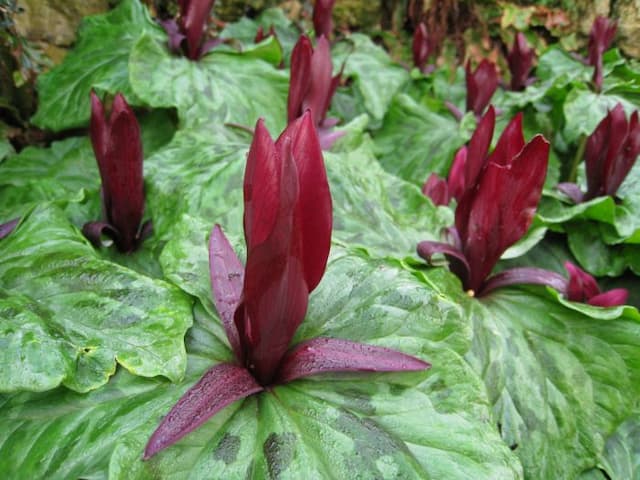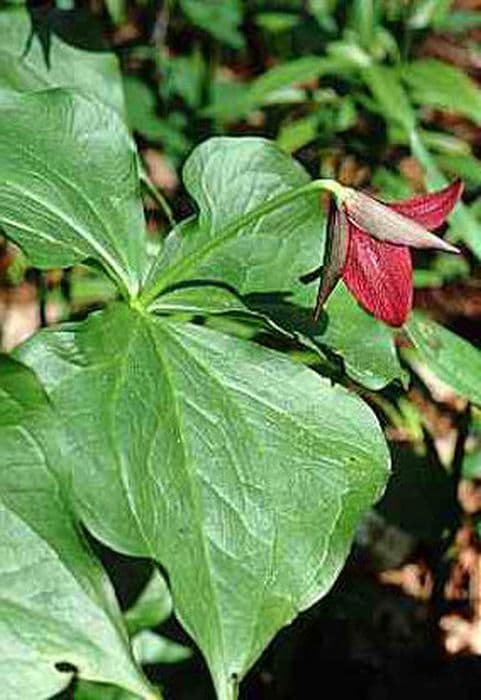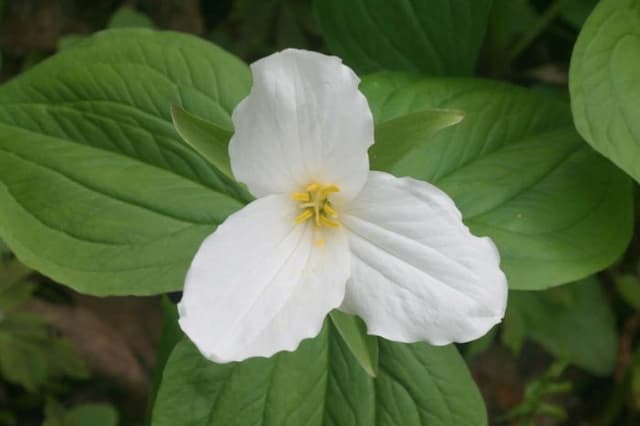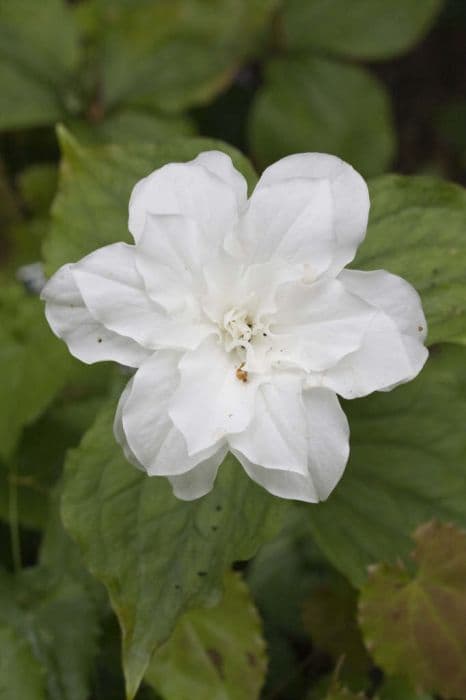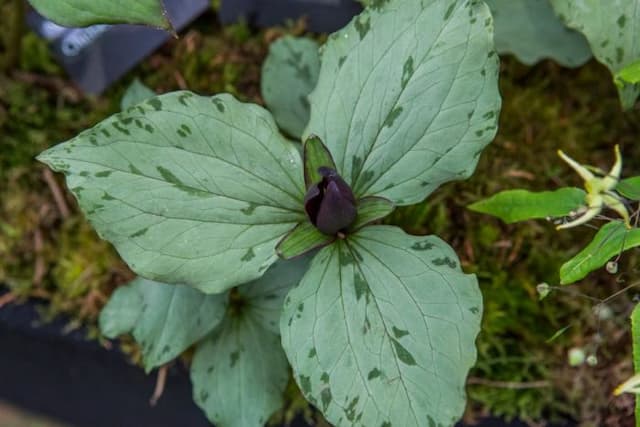White Trillium Trillium grandiflorum f. polymerum 'Snowbunting' (d)

ABOUT
'Snowbunting' is a distinctive variety of the commonly known White Trillium, which is often celebrated for its decorative qualities. Typical of its kind, it showcases a trio of large, broad leaves that provide a lush, green backdrop at the base of the plant. Splayed out symmetrically, these leaves exhibit a deep, verdant hue with pronounced veining, contributing to their textured look. Perched atop a single, slender stem that emerges from this whorl of foliage, is the plant's most striking feature – its flower. The flower is composed of three large, white petals, which are known for their pristine and somewhat waxy appearance. As the flower matures, it can develop a faint pink blush, which adds a subtle nuance of color to the otherwise pure white petals. Nestled at the center are a cluster of stamens topped with golden-yellow anthers, which create a pleasant contrast against the petals and lure in pollinators. The innermost part of the flower houses a prominent three-lobed ovary. The overall impression of 'Snowbunting' is one of elegant simplicity and classic woodland charm. Its clean white blooms, framed by the lush foliage below, make it a desirable addition to shade gardens and naturalistic plantings.
About this plant
 Names
NamesFamily
Melanthiaceae
Synonyms
Large White Trillium, Great White Trillium, White Wake-Robin, Snowbunting Trillium
Common names
Trillium grandiflorum 'Snowbunting'
 Toxicity
ToxicityTo humans
The plant known as Great White Trillium is not typically considered toxic to humans. However, ingesting any part of the plant is generally not recommended as it is not known to be edible and thus could potentially cause mild stomach upset or digestive discomfort due to the plant's natural compounds.
To pets
Great White Trillium is not commonly known to be toxic to pets. Like with humans, it's not intended for consumption, and eating parts of the plant may cause mild gastrointestinal irritation in some pets, but it is not expected to cause severe poisoning. Always monitor your pets and prevent them from eating ornamental plants as a precaution.
 Characteristics
CharacteristicsLife cycle
Perennials
Foliage type
Deciduous
Color of leaves
Green
Flower color
White
Height
1-2 feet (30-60 cm)
Spread
1-2 feet (30-60 cm)
Plant type
Herb
Hardiness zones
4
Native area
North America
Benefits
 General Benefits
General Benefits- Aesthetic Appeal: Trillium grandiflorum 'Snowbunting' adds visual interest to gardens with its distinctive three-petaled white flowers and attractive foliage.
- Wildlife Attraction: The flowers can attract pollinators such as bees and butterflies, supporting local ecosystems.
- Shade Tolerance: This plant is well-suited for shaded areas, where other plants might struggle to grow.
- Spring Interest: Blooming in spring, it provides early-season color when many other plants are not yet in bloom.
- Naturalizing: Over time, Trillium can spread and naturalize in suitable conditions, creating a woodland aesthetic.
- Low Maintenance: Once established, this plant requires minimal care beyond ensuring its preferred moist and well-drained soil conditions.
- Erosion Control: The foliage of Trillium grandiflorum 'Snowbunting' can help reduce soil erosion in shaded landscapes and sloped areas.
 Medical Properties
Medical PropertiesThis plant is not used for medical purposes.
 Air-purifying Qualities
Air-purifying QualitiesThis plant is not specifically known for air purifying qualities.
 Other Uses
Other Uses- Trilliums can be used in shade gardens to add aesthetic appeal due to their large, showy flowers.
- As a symbol of purity and elegance, Trilliums are sometimes featured in floral arrangements for weddings and sophisticated events.
- The white flowers can be a natural indicator of seasonal change, as they typically bloom in the spring, signaling the end of winter in temperate regions.
- Trillium grandiflorum is occasionally used in botanical art and photography due to its striking appearance.
- Some people use Trilliums as a natural dye source, though this is less common and requires a significant number of flowers.
- The plant could be used in educational settings as a specimen to study plant biology and reproduction, given their interesting three-part symmetry.
- In native cultures, trilliums have sometimes been associated with various myths and legends, making them useful for cultural storytelling and heritage crafts.
- They can be a component of a woodland restoration project, helping to support local ecosystems and biodiversity.
- Gardeners may utilize Trilliums as part of a butterfly or pollinator garden to attract bees and other pollinating insects.
- Trillium grandiflorum's distinctive three-petaled flower design could inspire artists, fashion designers, and architects in their work, translating organic patterns into creative projects.
Interesting Facts
 Feng Shui
Feng ShuiThe Large-flowered Trillium is not used in Feng Shui practice.
 Zodiac Sign Compitability
Zodiac Sign CompitabilityThe Large-flowered Trillium is not used in astrology practice.
 Plant Symbolism
Plant Symbolism- Elegance: The Trillium grandiflorum, commonly known as the Great White Trillium, is often associated with elegance due to its striking shape and delicate white petals.
- Purity: With its pristine white flowers, Great White Trillium is symbolic of purity and innocence.
- Resilience: As a woodland plant that emerges after harsh winters, it represents resilience and the ability to overcome challenges.
- Recovery: Trilliums are often seen as a sign of recovery and healing, especially since they are used in some traditional medicines.
- Trinity: The three petals of the Great White Trillium are sometimes used to symbolize concepts that come in threes such as the Christian Holy Trinity or the tripartite nature of the world (Heaven, Earth, and Other worlds).
 Water
WaterThe Great White Trillium requires consistent moisture, especially during the spring growth and flowering period. It should be watered thoroughly once a week, ensuring the soil is moist but not waterlogged. During the active growth phase, aim for about 1 gallon per plant each week, adjusting based on rainfall and soil drainage. In the dormant season, reduce watering frequency to prevent root rot, as the plant will require less water.
 Light
LightGreat White Trillium thrives in dappled sunlight, characteristic of woodland settings. The ideal spot would mimic its natural habitat, providing filtered light, such as under deciduous trees where sunlight can pass through the sparse foliage. Full sun can be tolerated in cooler, Northern climates if moisture is consistent, but in general, partial shade is best to protect the foliage from scorching.
 Temperature
TemperatureWhite Trillium prefers temperate conditions and is hardy in USDA zones 4 through 9. It can withstand a minimum temperature of around -30°F and a maximum of 80°F, but grows best when temperatures are between 50°F and 70°F. Excessive heat or frost can damage the plant, so it is important to ensure it is planted in an area where temperatures remain within this range.
 Pruning
PruningPruning is not commonly needed for Great White Trillium, as it is a low-maintenance plant. However, you may remove dead or yellowing leaves in the autumn to tidy up the plant and encourage healthy growth for the following season. Cutting back the foliage after it has yellowed can prevent disease and may help the plant conserve energy for the next year.
 Cleaning
CleaningNot needed
 Soil
SoilFor Great White Trillium (Trillium grandiflorum), a soil mix rich in organic matter works best, with well-rotted leaf mold or compost amended into it. The soil should be well-draining yet able to retain some moisture. Acidic to neutral pH, ranging from about 5.5 to 7, is ideal for this species.
 Repotting
RepottingGreat White Trillium typically does not need frequent repotting as it is a perennial that's often grown outdoors. If grown in containers, repotting every 2-3 years in the spring can help refresh the soil and accommodate the slowly expanding rhizome.
 Humidity & Misting
Humidity & MistingGreat White Trillium prefers moderate humidity levels similar to its native woodland habitats. Ensuring a humidity level of roughly 50-60% is usually sufficient for the healthy growth of this plant.
 Suitable locations
Suitable locationsIndoor
Ensure shade, cool temperatures, moist, rich soil.
Outdoor
Part-shade, rich soil, moist conditions, woodland setting.
Hardiness zone
4-9 USDA
 Life cycle
Life cycleTrillium grandiflorum f. polymerum 'Snowbunting'—commonly known as the great white trillium—begins its life cycle with seed germination, typically taking place in spring, which requires a period of cold stratification to break dormancy. Following germination, a rhizome develops from which a single shoot emerges, producing a whorl of three leaves and a single, large, white flower that blooms in late spring. After pollination, often by insects such as bees, the flower is followed by a berry-like fruit containing seeds, which are frequently dispersed by animals. The plant then enters a period of vegetative growth, where it expands via its rhizome to form clonal colonies. During the winter months, the above-ground parts die back, while the rhizome persists underground in a period of dormancy. Each year, the cycle repeats as the plant emerges again in the spring, gradually maturing over several years to reach full size and optimal reproductive capability.
 Propogation
PropogationPropogation time
Spring to early summer
The most popular method of propagation for the Trillium grandiflorum f. polymerum 'Snowbunting', commonly known as the large-flowered trillium or white trillium, is through division. This is ideally done in late summer to early fall, after the plant has flowered and is going dormant. To propagate by division, carefully dig up the entire plant, making sure not to damage the rhizome. With a sharp knife or spade, divide the rhizome into smaller sections, ensuring that each section has at least one growth point. These divisions can then be immediately replanted in a shaded location with rich, well-draining soil, spaced approximately 6 to 12 inches apart, which translates to 15 to 30 centimeters. It is crucial to minimize the time the roots are exposed to the air, so the divisions should be replanted quickly to prevent them from drying out. Water the new plantings thoroughly to help establish them.
